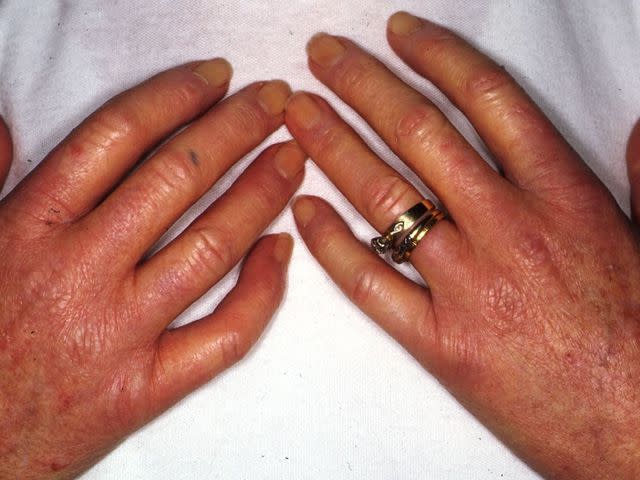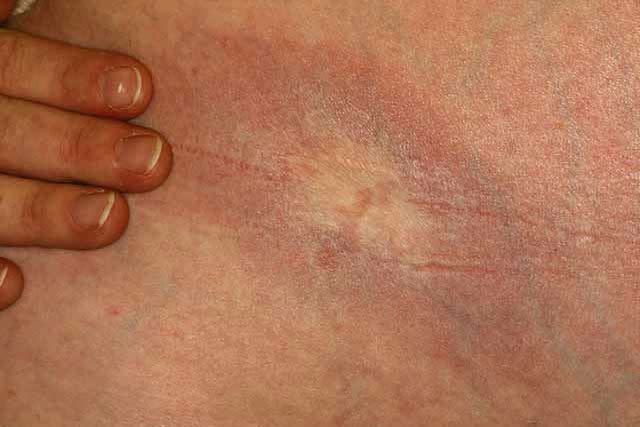Scleroderma Pictures: How Rash Symptoms Look
Medically reviewed by Susan Bard, MD
Scleroderma is an autoimmune condition in which the body produces too much collagen. This affects the skin by causing it to be tight and shiny and can also affect internal organs, causing significant organ dysfunction. Most often, scleroderma is seen on the arms, legs, and face but can occur anywhere.
This article will talk about how scleroderma looks, its symptoms, and how it's diagnosed.

Localized Scleroderma
Localized scleroderma—also known as morphea—slowly develops and only involves the skin on the abdomen, chest, or limbs. It does not typically affect the hands and face or internal organs. It can either get better and go away or continue for extended periods.
Rash Characteristics
Localized scleroderma rash has a few unique characteristics. The condition causes thick, hard skin but can take on two distinctive patterns. They are called morphea, or linear. Below are the characteristics of morphea:
Shape: Oval, one-half inch or larger in diameter
Color: Red, purple, or yellow and waxy
Edges: Red or bruised looking
The morphea rash patches can grow together and form larger rashes. The rash may be itchy but not painful.
Another form of localized scleroderma is linear scleroderma. This form usually starts when someone is a child or teenager. The condition causes a thickened skin line or different color skin to form on the leg or arm. It can continue deeper into the skin, going into the muscles and occasionally the bones.

Reproduced with permission from © DermNet New Zealand www.dermnetnz.org 2023.
Other Affected Body Parts
Facial scleroderma is another form of localized scleroderma that can form on both the scalp and the face. It causes a thick line to form on the face or scalp.
A severe variation of linear scleroderma on the face is called en coup de sabre, translating to "the blow of the sword." This condition can affect both the face and scalp. It causes a scarred line that indents into the skin on the scalp and skull, like a sword wound. The condition can also cut into the brain, causing neurological changes.

Reproduced with permission from ©DermNet New Zealand and © Raimo Suhonen www.dermnetnz.org 2023.
Systemic Sclerosis (Involving Internal Organs)
Systemic scleroderma is also called sclerosis. This form of the condition not only affects the skin but also internal organs like the lungs, kidneys, and heart. There are two types of sclerosis, limited and diffuse.
Associated Symptoms
Limited systemic scleroderma is known as CREST syndrome. This acronym characterizes the symptoms associated with the condition, as follows:
C: Calcinosis, calcium deposits located on the skin
R: Raynaud's phenomenon, the fingers turn white or blue when cold
E: Esophageal dysfunction, with acid reflux or decreased esophageal motility
S: Sclerodactyly, when the skin on the hands and fingers becomes tight and shiny
T: Telangiectasia, red spots on the skin from dilated capillaries
Diffuse systemic scleroderma develops rapidly over weeks or months and causes thick, hardened skin on several areas of the body. This is from the large amount of collagen formation and can develop on internal organs.
Beyond Visual Symptoms: Scleroderma Complications
Scleroderma is a condition that can affect several areas of the body and cause numerous complications. Below is a list of complications grouped by body system.
Skin
Skin color changes
Sores
Tight skin
Muscle and Bone
Stiffness
Swelling
Gastrointestinal
Respiratory
Shortness of breath
Cardiac
Arrhythmia (irregular heartbeat)
Hypertension (high blood pressure)
Cardiac fibrosis (scarring of the heart muscle)
Decreased heart function
Urinary
Vaginal dryness
Diagnosing Scleroderma
Scleroderma must be diagnosed by a healthcare provider, usually a dermatologist or rheumatologist. The provider will examine the skin, looking for tightness and skin thickening. They will also look at the tips of the fingernails to look for changes in the blood vessels.
There is no single, specific scleroderma test. A skin biopsy (taking a sample of skin for analysis in a lab) can be used to look at the affected skin under a microscope. A blood test called elevated antinuclear antibodies is helpful but not a definite diagnosis. Approximately 95% of people with scleroderma will be positive for this test, but other conditions also have these antibodies.
Summary
Scleroderma is a condition that causes a distinctive change in the skin. The skin produces too much collagen, which causes tight, shiny skin. The skin can become so tight that it makes it difficult to move the joints. There are varying levels of disease severity. If someone suspects they have scleroderma, they should contact their healthcare provider for a diagnosis and treatment guidance.
Read the original article on Verywell Health.

